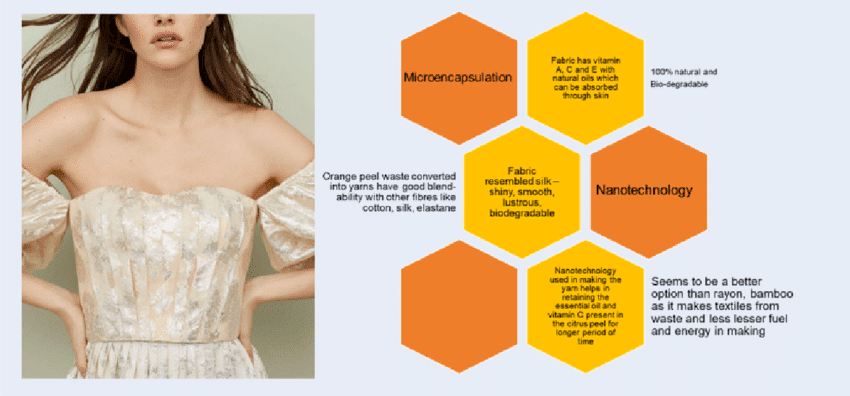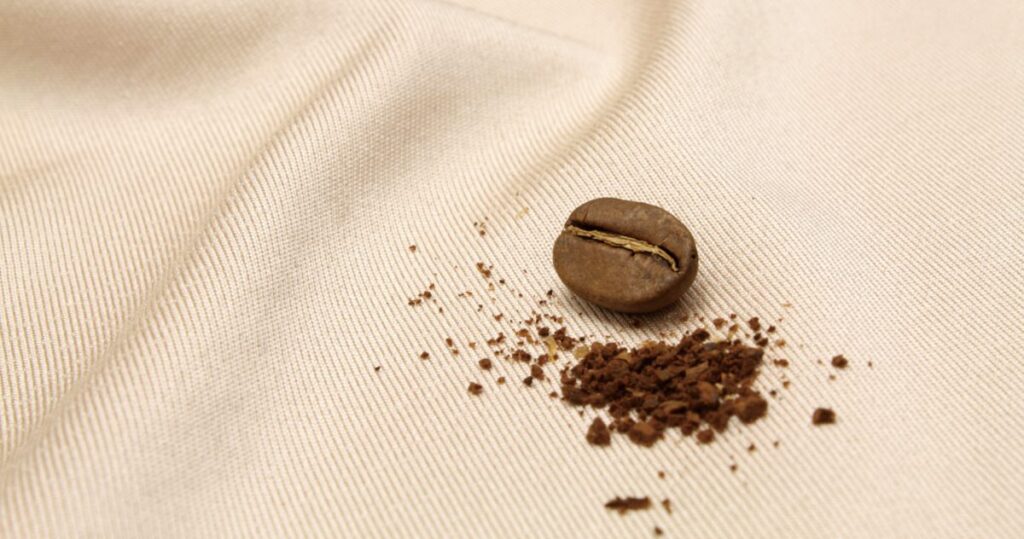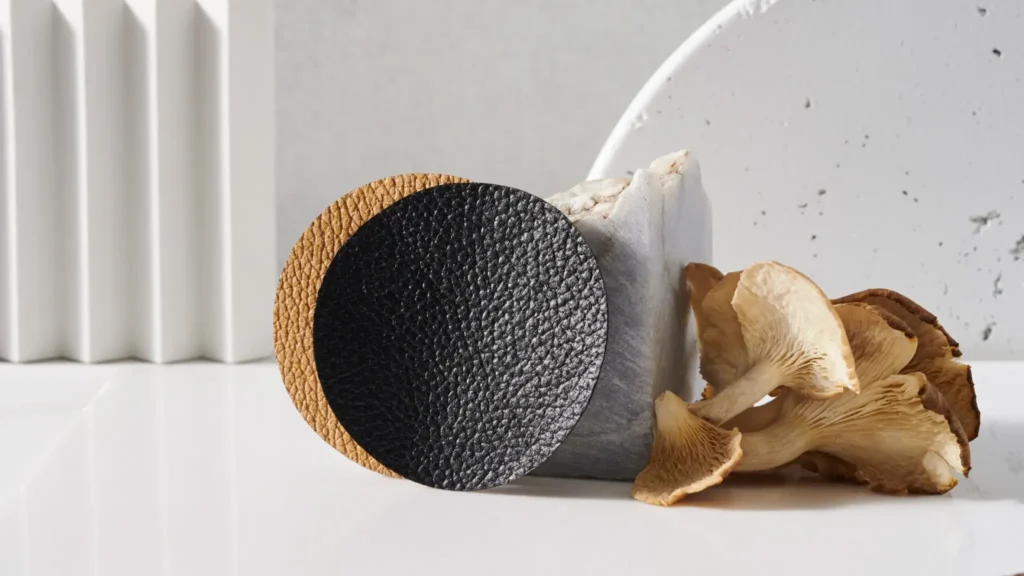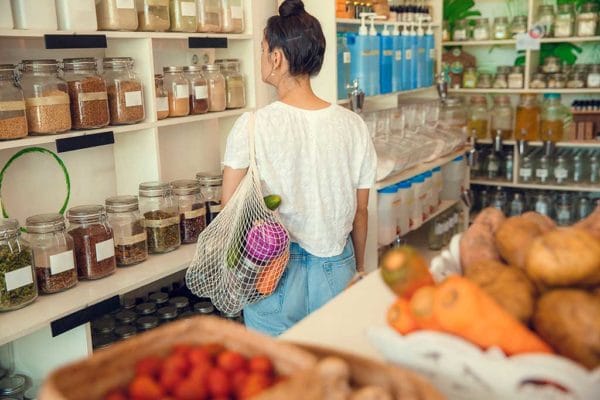From seaweed fibres to citrus peels, the next generation of textiles is turning waste and biology into the future of sustainable fashion.
We first wrote this post in 2019, when some of the most exciting innovations in sustainable fashion were Piñatex (pineapple leather) and hemp, finally going mainstream.
Fast forward six years to 2025, and the future of fabric has become a lot more interesting and a lot more weird. Today, you can wear fibres from citrus peels, seaweed, mushrooms, even coffee grounds.
Image via Stella McCartney

None of these materials is perfect. Every fabric leaves a footprint. But some are undeniably better than others, and what they represent is a growing shift in how we think about what we wear, where it comes from, and where it goes when we’re done with it.
Why Fabric Choice Matters for Sustainability
Fashion is responsible for around 10% of global carbon emissions, with textile production alone pumping out more CO2 than maritime shipping and all international flights combined.
The environmental cost of clothing starts with the materials we use. Polyester and cotton still dominate, but their impacts are significant.
A few more sobering stats:
- Polyester (aka plastic) makes up over 50% of all global fibre production.
- Cotton, while natural, is thirsty and chemical-heavy unless grown organically.
- Only about 1% of clothing is recycled into new garments.
We need fibres that fit circular systems, use waste as a starting point, and ideally disappear when they’re no longer needed.
How to Tell if a Fabric is Sustainable
Sustainability in textiles is complex. It involves not only the raw materials but also the entire lifecycle of a garment. From how the fibre is grown or produced, to how it’s dyed, woven, transported, worn, and eventually disposed of.
Recent reports, including the 2023 Material Change Insights from Textile Exchange, emphasise the need to look beyond surface-level claims. Greenwashing remains a problem, with some brands highlighting a single sustainable fibre while obscuring high-impact processing or wasteful practices elsewhere in the supply chain.
With greenwashing rife in the textiles space, it’s important to look beyond sustainability claims and assess a fabric’s actual environmental and social impact. To truly understand a fabric’s sustainability, we need to ask a few key questions.
- Are the raw materials grown regeneratively, or salvaged from waste?
- How toxic (or clean) are the chemicals and dyes used in processing?
- Looking at water, land and energy use. How resource-hungry is it?
- The durability. Will it last more than one season?
- Considering the end-of-life. Can it be recycled, or will it just sit in landfill?
How Do Future Fabrics Compare?
Before we explore the new wave of textile innovations, it helps to understand where we’re starting from. Most clothing today is made from a handful of the traditional materials we’re most familiar with.
Polyester: The most common on the market today, especially for fast fashion. Derived from petroleum, polyester is cheap to produce and incredibly durable. But it sheds microplastics, emits high levels of greenhouse gases during production, and takes centuries to break down.
Conventional cotton: While natural and biodegradable, conventionally grown cotton is one of the most water- and pesticide-intensive crops on the planet. Organic cotton is a better option, but still comes with challenges like land use and labour conditions.
Viscose (rayon): A semi-synthetic made from wood pulp. Some versions are responsibly sourced and processed, but others contribute to deforestation and use highly toxic chemicals.
Bamboo Viscose: Often marketed as “eco-friendly” because bamboo grows quickly and requires little water, most bamboo fabrics on the market are actually bamboo viscose, a semi-synthetic fibre that uses the same chemical-heavy process as regular viscose. Unless mechanically processed (which is rare and typically labelled as “bamboo linen”), bamboo viscose is far from a clean material. It’s soft and affordable, which explains its popularity in everything from loungewear to activewear. But from a sustainability standpoint, the raw plant may be low impact, the processing is not.
ECOVERO™ (by Lenzing): A more responsible take on viscose, ECOVERO™ is produced from certified renewable wood sources in a closed-loop system that recycles water and significantly reduces emissions compared to conventional viscose. Developed by Austrian company Lenzing (also behind TENCEL™), it’s one of the more transparent options available. While still a chemically processed fibre, ECOVERO™ comes with third-party certifications and traceability, making it a better option if you’re choosing a semi-synthetic fabric.
While these legacy fibres still dominate the industry, a new generation of materials is emerging, made from food waste, fungi, algae, and regenerative crops. Many are still scaling, but they represent a shift away from fossil fuels and extractive farming, and toward more circular, biologically-inspired design.

Properties of textiles made from orange peel waste via Dr. S. Aishwariya
Next-Gen Fabrics
Piñayarn®
Developed by Ananas Anam, the same company behind Piñatex, Piñayarn™ is a natural fibre made from waste pineapple leaves. Unlike Piñatex, which is designed to mimic leather, Piñayarn is a lightweight yarn for use in woven and jersey fabrics. It’s compostable, free from petroleum-based coatings, and designed for circularity.
Stella McCartney debuted Piñayarn in her Autumn 2025 collection, using it in the uppers of the S-Wave Sport trainer — part of the brand’s push toward regenerative and plastic-free materials.
Orange Fiber
Made in Italy from citrus juice industry waste, Orange Fiber transforms leftover orange peel into a soft, silky textile that feels like a cross between viscose and cotton. The fibre is spun from cellulose extracted from citrus pulp, using a closed-loop process that recycles water and chemicals.
It’s still a niche fabric, recently used in capsule collections by Salvatore Ferragamo and several independent European designers. But it is popping up in smaller textile suppliers like this one in Maleny, Australia. While its sustainability credentials are strong at the raw material stage, wider adoption will depend on scaling its production and further transparency around chemical inputs.
SeaCell®
SeaCell® blends cellulose derived from wood pulp (usually eucalyptus) with Icelandic seaweed, resulting in a lightweight, breathable fabric. The seaweed is harvested using a non-invasive method that allows natural regeneration, and the fibre is made in a closed-loop process similar to lyocell.
Claims around mineral absorption through the skin remain debated, but SeaCell’s main strength lies in its relatively low-impact production and biodegradability. It’s been used in activewear and undergarments by brands looking for skin-friendly, moisture-regulating fabrics.
Bananatex™
Developed by Swiss bag brand QWSTION, Bananatex™ is made from the fibres of the Abacá banana plant, which grows without pesticides or irrigation in the Philippines. The fibre is mechanically extracted and spun into a strong, durable canvas-like fabric.
It’s fully biodegradable and free from synthetic coatings or finishes, making it a lower-impact alternative to nylon and polyester. Though primarily used in accessories and technical products, it’s currently being trialled in garments where a bit more structure is needed, like tailored outerwear and workwear.
Hemp
One you’d likely be more familiar with. Hemp is one of the most widely studied low-impact fibres, known for its fast growth, minimal water needs, and natural resistance to pests. It thrives without synthetic fertilisers or pesticides, and its long roots help stabilise and regenerate soil, making it well-suited to organic and regenerative farming systems.
While traditionally associated with coarse fabrics, modern processing methods have softened hemp’s texture, making it a viable option for everything from denim to everyday basics. A recent lifecycle analysis found hemp had one of the lowest global warming potentials among all natural fibres.

S.Café®
S.Café® is a technical fabric made from spent coffee grounds, collected from cafes and repurposed into yarn. The coffee is processed at low temperatures and infused into recycled polyester to create a fabric that dries quickly, resists odour, and offers UV protection.
While not compostable due to its synthetic base, S.Café® uses food waste that would otherwise go to landfill and adds performance properties without chemical finishes. Right now, it’s being used in sportswear, outerwear, and workwear, clothing that needs a bit more durability.
Kintra Fibers
A new bio-based alternative to traditional polyester, Kintra is made from a blend of corn-based sugars and other renewable inputs (we’re not clear on exactly what those are yet). It’s designed to mimic the strength and stretch of synthetics, but without the microplastic pollution or fossil fuel origins.
Unlike conventional polyester, Kintra’s fibres are compostable under industrial conditions and break down into non-toxic compounds. The company is still scaling production, but the potential for a lower-impact, high-performance fibre is looking good, particularly for activewear and base layers.
Infinna™
Developed by Finland’s Infinited Fiber Company, Infinna™ regenerates post-consumer textile waste into a cotton-like fiber that looks and feels like virgin cotton, but can be recycled again. The process captures the value of old clothes, closing the loop on otherwise hard-to-recycle materials.
Because it uses discarded clothing as feedstock, the idea is to help reduce textile waste and demand for new raw materials. Major brands like Ganni and PVH Corp. have partnered with Infinited Fiber, and is one of the most promising circular material solutions currently in development.
Naia™ Renew
Naia™ Renew offers a lower-impact alternative to traditional semi-synthetics. It blends 60% sustainably sourced wood pulp with 40% recycled content, including hard-to-recycle plastics that would otherwise end up in a landfill.
The fibre is made in a closed-loop system using certified non-toxic solvents, with low water use and reduced emissions. It’s already being used in soft staples like lingerie and linings, and compared to conventional viscose or acetate, it has a traceable supply chain and more circular intent.
TômTex
Still in early development, TômTex is a next-gen leather alternative made from chitosan (extracted from shrimp shells) and waste coffee grounds. It’s being positioned as a fully biodegradable, plastic-free alternative to traditional and synthetic leathers.
Founded by Vietnamese designer Uyen Tran, TômTex is still in the R&D phase, but it’s generating buzz for its mix of waste-based inputs and fully biodegradable design.
On Our Radar: Experimental Fabrics to Watch
Not every future fabric is ready for your wardrobe just yet, but some are getting close. These materials are still in development or early-stage production, but they show where things might be heading next.

Grown from mycelium but rivals the look and feel of animal leather
- Mylo™ & Reishi™ (Mycelium leather): Mycelium (mushrooms) can be grown into soft, leather-like sheets using agricultural waste as feedstock. Companies like Bolt Threads (Mylo™) and MycoWorks (Reishi™) have created early prototypes now used by Stella McCartney and Hermès. While the materials aren’t yet widely available, they’re among the most promising animal-free, plastic-free leather alternatives in development.
- SCOBY / Kombucha Leather: This leather-like material can be grown at home or in labs and made by fermenting a mixture of tea, sugar, and a symbiotic culture of bacteria and yeast (SCOBY). It’s fully biodegradable, requires no chemical tanning, and can be shaped like fabric. The catch? It’s extremely delicate and water-sensitive, which limits its use in wearables for now.
- Circulose® (Renewcell): Developed by Swedish company Renewcell, Circulose is a high-purity cellulose pulp made entirely from discarded clothing. It’s designed to replace virgin cotton and wood-based viscose in textile production — and brands like Levi’s and Ganni are already using it. Because it’s made from textile waste, Circulose helps close the loop and reduce the need for new raw materials.
- Agraloop™ BioFibre: By turning food crop waste, like hemp stalks and banana stems, into fibre, Agraloop is helping solve two problems at once: agricultural waste and textile emissions. Life Cycle Assessments suggest it requires less water and creates fewer emissions than cotton or linen. Several global brands are already exploring its use in tees, dresses, and blended fabrics.
What’s Next for Sustainable Fabrics?
No fabric is perfectly sustainable, and no single innovation will fix fashion’s systemic problems. But the rise of waste-based fibres, regenerative crops, and closed-loop systems shows a growing shift toward better material choices.
Projects like Stella McCartney’s partnership with Mylo, PANGAIA’s work with seaweed fibre, and Fashion for Good’s “Sorting for Circularity” initiative show how science, startups, and brands are beginning to close the gap between concept and commercial viability. Meanwhile, platforms like the Textile Exchange and Canopy continue to map and measure material impact at scale.
The future of fashion won’t be perfect. But it can be better. And if it includes fibres made from mushrooms, mango skins and marine waste, it will definitely be more interesting.


